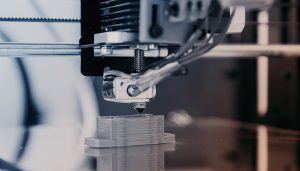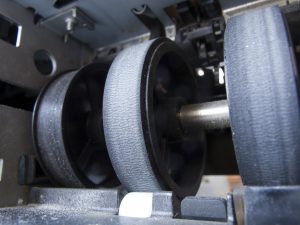3D Printing Technologies (Part 2)
Part Two: 3D Printing Technologies

3D printing—also known as additive manufacturing (AM)—offers a wide range of different printing technologies to choose from. While significant differences may exist between each method, all 3D printing techniques operate on the same basic principle: Additive manufacturing technologies build workpieces either layer by layer or by deposition along a programmed path.
Based on the method for making layers, 3D printing technology mainly breaks down into seven categories:
1. Metal Extrusion
A nozzle or other orifice selectively dispenses material. After a layer is completed, the build platform moves down or the extrusion head moves up, and the next layer is extruded and adhered to the previous layer. This technology mainly deals with materials such as:
- Thermoplastics
- Eutectic metals
- Ceramics
- Composites
- Modeling clay
- Metal-filled clays
- Concrete
- Food
- Living cells
This technology includes two subcategories: fused deposition modeling (FDM) or fused filament fabrication (FFF). The primary providers of this technology include Stratasys, Arbur, Aleph Objects, Beijing Tiertime, MarkerBot Industries, and Ultimaker. Metal extrusion technology represents the largest installed base of AM machines. The process was pioneered by Stratasys.
2. Material Jetting
One or more inkjet printing heads deposit small drops of the building material as they move across the powder bed. Since multiple print heads can be used, each can print different materials. This technology can also adopt a “direct-write” technology, which atomizes nanoparticle-sized print materials and combines them with an inert carrier gas into an aerosol, and then propels the aerosol onto a surface.
This technology deals with materials such as:
- Photopolymers
- Wax-like materials
- Metals/non-metals
- Conductors
- Dielectrics
The primary providers include 3D Systems, Stratasys, Solidscape, and Keyence. This technology can produce investment casting patterns.
3. Binder Jetting
 Binder jetting fastidiously deposits a liquid binding agent using inkjet print head nozzles to join powder materials. Unlike material jetting, the material dispensed through the nozzle is not the raw building material but instead a liquefied binding material which is deposited onto a bed of powder to hold the powder in the desired shape.
Binder jetting fastidiously deposits a liquid binding agent using inkjet print head nozzles to join powder materials. Unlike material jetting, the material dispensed through the nozzle is not the raw building material but instead a liquefied binding material which is deposited onto a bed of powder to hold the powder in the desired shape.
This technology works with:
- Acrylic polymer
- Metal
- Sand
- Ceramic
The primary providers of this technology include 3D Systems, ExOne Company, Voxeljet Technology GmbH, Microjet Technology, Digital Metal, and HP. This method may be used to build sand patterns for the sand casting process.
4. Sheet Lamination
Sheet lamination bonds layers of sheet material to realize a design. Sheet materials will either be papers treated with adhesive that form solid similar to plywood when laminated into the fully formed object, or metal foils and tapes that instead create metal parts. Sheet lamination is also called Laminated Object Manufacturing (LOM).
The primary providers of this technology include Helisys, Micro Technologies, and Fabrisonic.
5. Vat Photopolymerization
Liquid photopolymer contained within a vat is selectively cured using light-activated polymerization. This technology only works with photopolymers. There are two types of vat photopolymerization technologies currently on the market.
- Stereolithography (SLA) uses an ultraviolet laser and X-Y scanning mirrors mounted on computer-guided galvanometers to cure the top layer of liquid photopolymer in the vat. Each point touched by the laser is then cured. SL was the undisputed leading process in the early years of AM.
- Vat polymerization has expanded to also include digital light processing (DLP). Instead of using a laser as a light source for curing, DLP AM printers feature a digital light projector screen to project and cure the entire layer image at once.
The primary providers of this technology include 3D Systems, Envisiontec, DWS, Asiga, and Rapid Shape, among others.
6. Power Bed Fusion
Thermal energy selectively fuses regions of a powder bed. The thermal energy melts the powder material, which then changes to a solid phase as it cools. The energy source used in this technology could be either a laser or an electron beam.
This process is also known as:
- Laser Sintering
- Direct Metal Laser Sintering
- Selective Laser Sintering
- Electron Beam Melting
- Selective Laser Melting
The laser-based technology produces better surface finishes and finer details than electron beam set ups. Electron beams are more costly up front, but they are also faster and produce parts that with lower levels of residual stress.
The majority of metal AM systems employ the powder bed fusion process. EOS is a well-established metal AM process with the largest installed base. High energy powder bed fusion (PBF) processes threaten to take market share from the traditional investment casting industry despite its high cost. PBF processes can produce complex 3D shapes from alloys that nearly match the metallurgical qualities of investment castings. SLM is the most mature AM method and commands over 70% of the metal printing market.
This technology works with polymers, metal, and sand. The primary providers include 3D systems, EOS, Arcam, SLM Solutions, Realizer, Concept Laser, Aconity3D, Proto Labs, and more.
7. Directed Energy Deposition
Thermal energy is used to fuse materials as the material is being deposited. In most cases, a laser is the source of the energy, and the material is a type of metal powder. A 4- or 5-axis motion system is used to position the deposition head. This technology only works with metal materials, but more than one type of metal material can be used at a time.
The primary providers of Directed Energy Deposition (DED) technology include Optomec, POM Group, BeAM, Trumpf, RPM and Innovations. DED is also known as Blown Powder AM and Laser Cladding. This is a suitable method for adding material existing workpieces, making it optimal for the repair or modification of parts.
Staying Current with Impro
At Impro, we strive to stay up to date on the latest manufacturing technologies and how they can benefit our customers. If you would like to know more about 3D printing and how it compares with more traditional manufacturing methods, please download our free eBook.
To discover more about the future of 3D Printing, stay tuned for Part 3 of our three-part series on the topic, which will focus on inspection and testing. You can also download our free eBook— “3D Printing vs. Conventional Manufacturing”— today!
